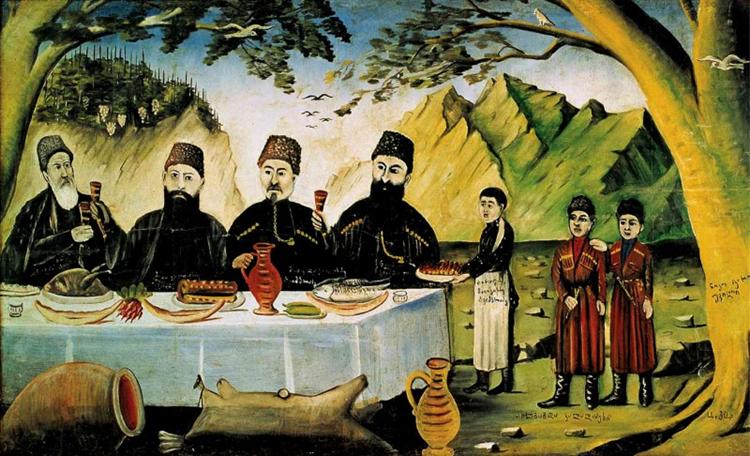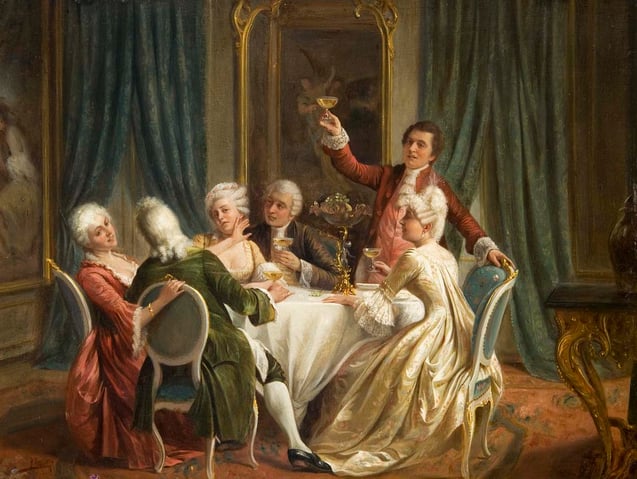At weddings and gatherings large and small, toasting is the norm. However, how did raising a glass as respect to a person or an idea become part of our collective long-standing hospitality traditions?
Myth and tradition
To answer the question, we’ll dispel a myth. You may have heard that the tradition of toasting originated out of a fear of poisoning- the idea being that clinking two glasses together would cause the liquid from both to spill into one another; thus, the people you’re drinking with wouldn’t poison you as they’d then be poisoning themselves. However, there is no evidence to support this assumption.
In fact, most ancient societies show evidence of doing this. For instance, as early as the 6th Century B.C., the Ancient Greeks would offer libations to the Gods as a ritualistic practice, as well as make a point of drinking to each other’s health. The Romans placed such an importance on drinking to health that at one point in time the Senate passed a decree that stated that all must drink to Emperor Augustus at every meal.
Some other historians hold that clinking glasses provided the noise that would keep the demons and evil spirits at bay. People would clink glasses together in order to replicate the sound of church bells ringing.

Hip, Hip, Hurrah! by P.S. Krøyer, 1888
Wind and toast
Possibly the most entertaining theory dates back to the 16th century from the Roman practice. One of the first written accounts of it was in Shakespeare’s The Merry Wives of Windsor when the character of Falstaff demands “Go fetch me a quart of sack; put a toast in’t.” To translate, he’s asking for a great deal of wine with a piece of (literal) toast in it, which was a common practice at the time due to the poor quality of wine. Thus, placing a piece of toast within a jug was supposed to soak up some of the acidity and improve the flavor.
Popularity of toasting
By the 18th century, the term “toast” had been transferred from the floating bread to the person honored by the toast - hence the particularly popular could become the “toast of the town.” Party-goers even liked to toast to the health of people not present, usually celebrities and especially beautiful women. Toasting became so popular that Toastmasters came into being. Acting as a kind of party referee, they were there to ensure that the toasting didn’t become too excessive and that everyone got their fair share of toasting opportunities.

Family feast by Niko Pirosmani, 1907
The anti-toast movement
As hybrid forms of toasting emerged, such as drinking from women’s shoes and even mixing one’s own blood with wine, an anti-toasting movement was born. People were becoming so drunk and reckless that many venues actually banned toasting altogether.
The first temperance society, the Order of Temperance, established in Germany in 1517, was dedicated to abolishing toasts. Louis XIV banned toasting at his court; and puritanical Massachusetts, in 1634, banned the “abominable” custom of drinking to another’s health.
Others, instead of eliminating toasts altogether, opted for refurbishing their tarnished image. An early book of toasting was “The Toastmasters Guide” published by T. Hughes, which strove to instill proper toasting etiquette within the reader. Hence, toasting became more of a civilized, restrained and intellectual pursuit.

A Toast by August Hermann Knoop, 1919
Nowadays
Today, the ritual of toasting seems more popular than ever. Yet it remains a standard and nearly universal way to begin a drinking session or meal and often seen at hospitality and tourism special events. Toasting in different countries does have its own particular nuances. According to Etiquette International, there are interesting differences in Korean and Japanese toasting customs.
“In Korea, the glass is emptied and the last few drops are shaken out, then it is passed to the guest and the host refills the glass. A glass is never refilled until it is completely empty in Korea, whereas in Japan the glass is constantly refilled so it is never empty.”
Even as it has become a standard expectation with small variations, a toast is also more than a few shared words in a moment of celebration. The toast has evolved into something of a verbal souvenir: “It’s something you take home with you as sort of a remembrance of that time”.





